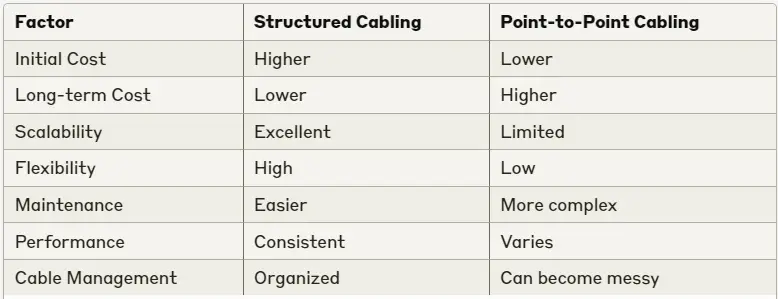At Encom, our expertise in electrical system design and construction extends to low-voltage and structured cabling services. We partner with many businesses nationwide, who trust us to design and build robust network infrastructure alongside reliable electrical service.
For every project, one of the first questions we need to consider is the design of network topology. How is the facility going to be wired? How are devices going to be powered? It’s different every time. Whether setting up a new office, upgrading your current network, or planning a large-scale infrastructure project, understanding the pros and cons of both cabling methods is the first step to making informed decisions about the design of your network.
More often than not, a combination of both methods is used to address different needs and functions of devices on the network. The following gives you a breakdown of the types of cabling, showing features, advantages, and use cases for both. The chart at the end of the post shows a quick side-by-side comparison that will help you better understand the pros and cons.
Structured Cabling
A planned and systematic cabling infrastructure design, using centralized points (hubs) along with secondary points (subpanels) for distribution. Here are the key features of a network designed with structured cabling:
Organized
Uses patch panels and cable management systems.
Scalable
Easily accommodates network growth.
Flexible
Supports multiple applications (data, voice, video).
Standardized
Follows TIA/EIA standards.
Advantages of Structured Cabling
- Easier troubleshooting and maintenance.
- Reduced downtime during moves, adds, and changes.
- Better long-term cost-effectiveness.
- Improved air flow and cooling efficiency.
Structured Cabling Is Best For
- Large offices, commercial spaces, warehouses, and manufacturing facilities.
- Data centers and logistics hubs.
- Buildings with frequent layout changes.
Point-to-Point Cabling
Direct connections between networked devices, also known as 'home run' cabling. Here are a few of the key features of point-to-point cabling design:
Simple
Direct device-to-device connections
Custom
Tailored to specific network needs.
Immediate
Quick to set up for small networks.
Visible
Cable paths are easily traceable
Advantages of Point-to-Point Cabling
- Lower initial costs for small setups.
- Simpler installation process.
- Direct control over each connection.
- Potentially faster performance for short distances.
Point-to-Point Cabling is Best For
- Small offices or home networks.
- Temporary setups.
- Specific high-performance applications.
A Side-by-Side Comparison
Different factors affect the decision of which type of cabling to use. New classes of power cabling that combine high voltage electric with low-voltage connectivity are beginning to blur the lines between these two cabling methods. We'll get more into that in a future article. In the meantime, a quick look at this chart will give you a solid idea of how your network infrastructure should be designed.
